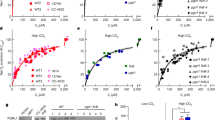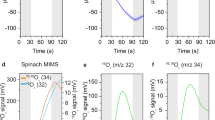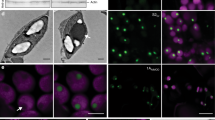Abstract
CHLOROPLAST suspensions from Spinacea oleracea or Pisum sativum assimilate CO2 in the light at rates comparable with those observed with intact leaves1–3. With most preparations the major photosynthetic products are phosphoglyceric acid (PGA) and dihydroxyacetone phosphate (DHAP)2,4,5. Although the synthesis of these compounds is consistent with the operation of the photosynthetic carbon reduction (PCR) cycle6 in the isolated plastids it is still not clear why these particular intermediates accumulate. It has been shown5 that the outer membranes of the chloroplasts are permeable to both PGA and DHAP. Thus a large proportion of the carbon fixed into these compounds may diffuse into the external medium. The amount of carbon lost from the chloroplasts will presumably depend on the ratio of the volume of external medium to that of the aqueous phase of the chloroplasts. For chloroplast suspensions containing 100 µg chlorophyll per ml. this ratio would be over 100 : 1, contrasting markedly with the fluid environment of the chloroplasts in vivo, where the ratio of the volume of non-chloroplastic cytoplasm to that of the chloroplasts is usually less than one. It seemed possible, therefore, that more of the PGA and DHAP formed might be metabolized further if the volume of medium in the experimental sample was reduced to a minimum by layering the chloroplasts on filter paper.
This is a preview of subscription content, access via your institution
Access options
Subscribe to this journal
Receive 51 print issues and online access
$199.00 per year
only $3.90 per issue
Buy this article
- Purchase on Springer Link
- Instant access to full article PDF
Prices may be subject to local taxes which are calculated during checkout
Similar content being viewed by others
References
Walker, D. A., Plant Physiol., 40, 1157 (1965).
Jensen, R. G., and Bassham, J. A., Proc. US Nat. Acad. Sci., 56, 1059 (1966).
Kalberer, P. P., Buchanan, B. B., and Arnon, D. I., Proc. US Nat. Acad. Sci., 57, 1542 (1967).
Walker, D. A., in Biochemistry of Chloroplasts (edit. by Goodwin, T. W.), 2, 53 (Academic Press, London and New York, 1967).
Bassham, J. A., Kirk, Martha, and Jensen, R. G., Biochim. Biophys. Acta, 153, 211 (1968).
Bassham, J. A., and Calvin, M., The Path of Carbon in Photosynthesis (Prentice Hall, Englewood Cliffs, 1957).
Cockburn, W., Walker, D. A., and Baldry, C. W., Plant. Physiol., 43, 1415 (1968).
Bucke, C., Baldry, C. W., and Walker, D. A., Biochem. J., 101, 636 (1966).
Benson, A. A., Bassham, J. A., Calvin, M., Goodale, T. C., Hass, V. A., and Stepka, W., J. Amer. Chem. Soc., 72, 1710 (1950).
Galmiche, J. M., in La Photosynthèse (Coll. Intern. CNRS), 589 (1963).
Everson, R. G., Cockburn, W., and Gibbs, M., Plant Physiol., 42, 840 (1967).
Author information
Authors and Affiliations
Rights and permissions
About this article
Cite this article
COOMBS, J., BALDRY, C. CO2 Assimilation by Chloroplasts illuminated on Filter Paper. Nature 228, 1349–1350 (1970). https://doi.org/10.1038/2281349b0
Received:
Revised:
Issue Date:
DOI: https://doi.org/10.1038/2281349b0
This article is cited by
-
Photosynthetic oxygen evolution and chlorophyll fluorescence in intact isolated chloroplasts on a solid support: the influence of orthophosphate
Planta (1991)
-
Metabolic regulation in C4 photosynthesis: Phosphoenol pyruvate carboxylase and 3C intermediates of the photosynthetic carbon reduction cycle
Planta (1975)
-
Photosynthesis and Gas Exchange of Acetabularia Chloroplasts in an Artificial Leaf
Nature (1971)
Comments
By submitting a comment you agree to abide by our Terms and Community Guidelines. If you find something abusive or that does not comply with our terms or guidelines please flag it as inappropriate.



